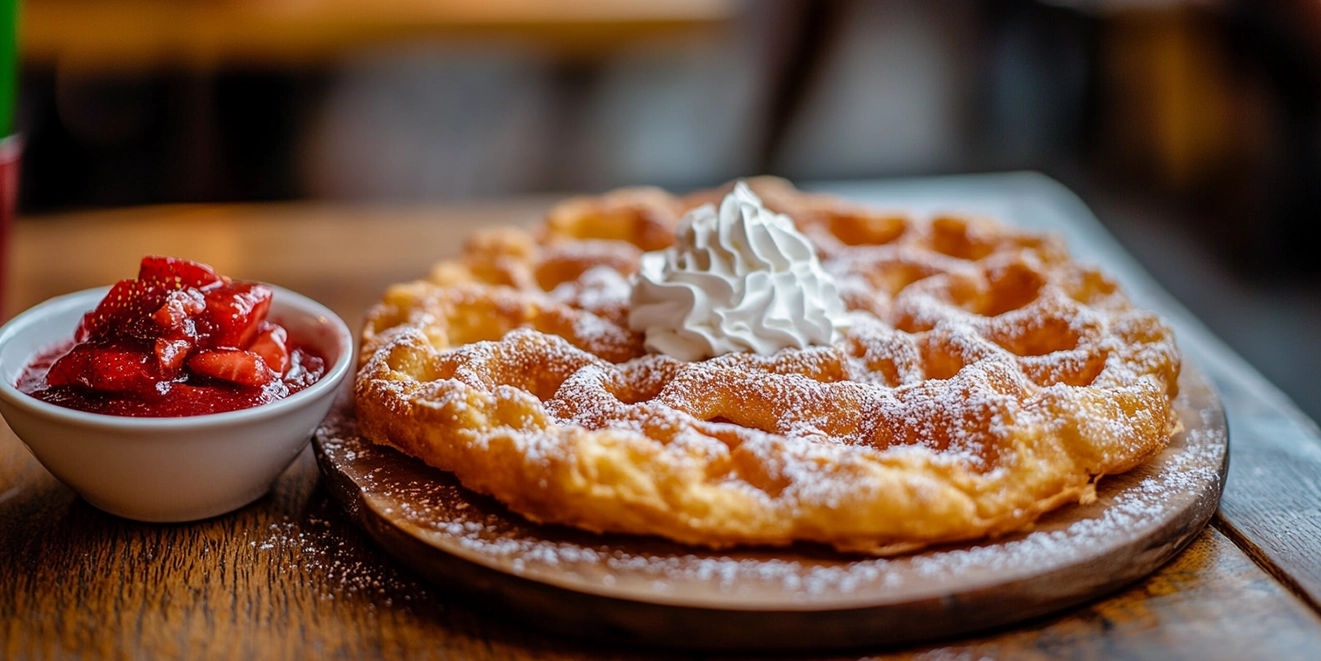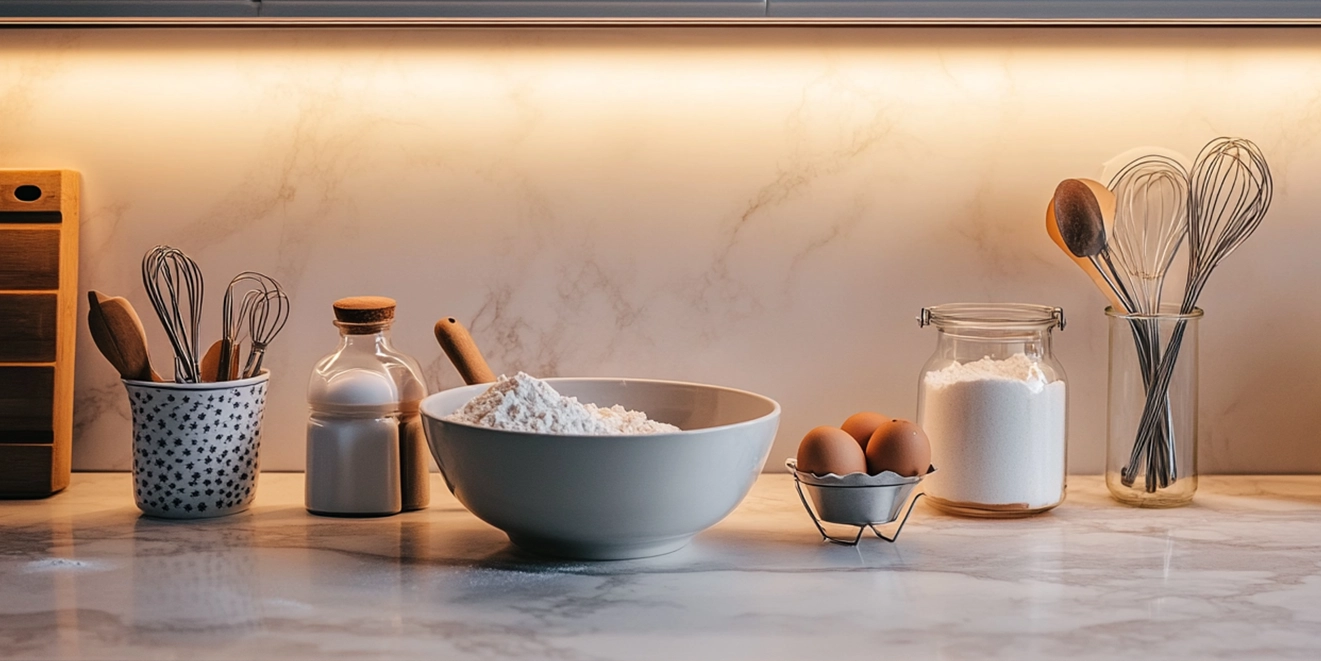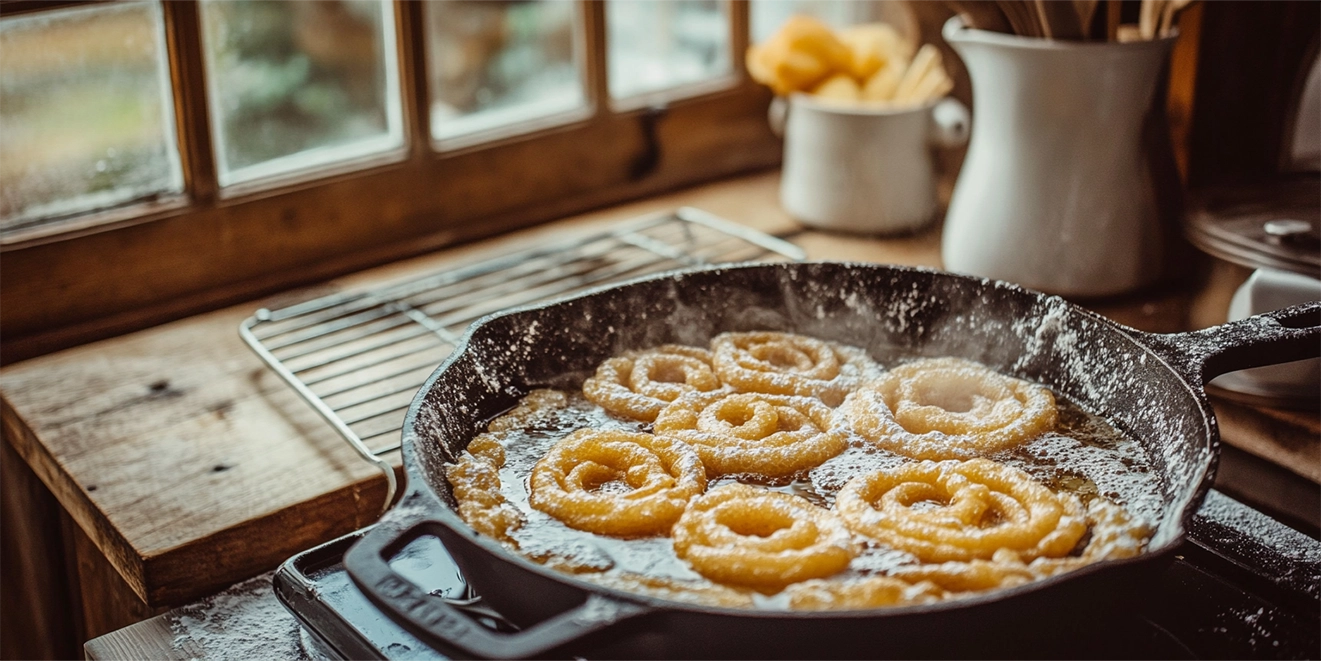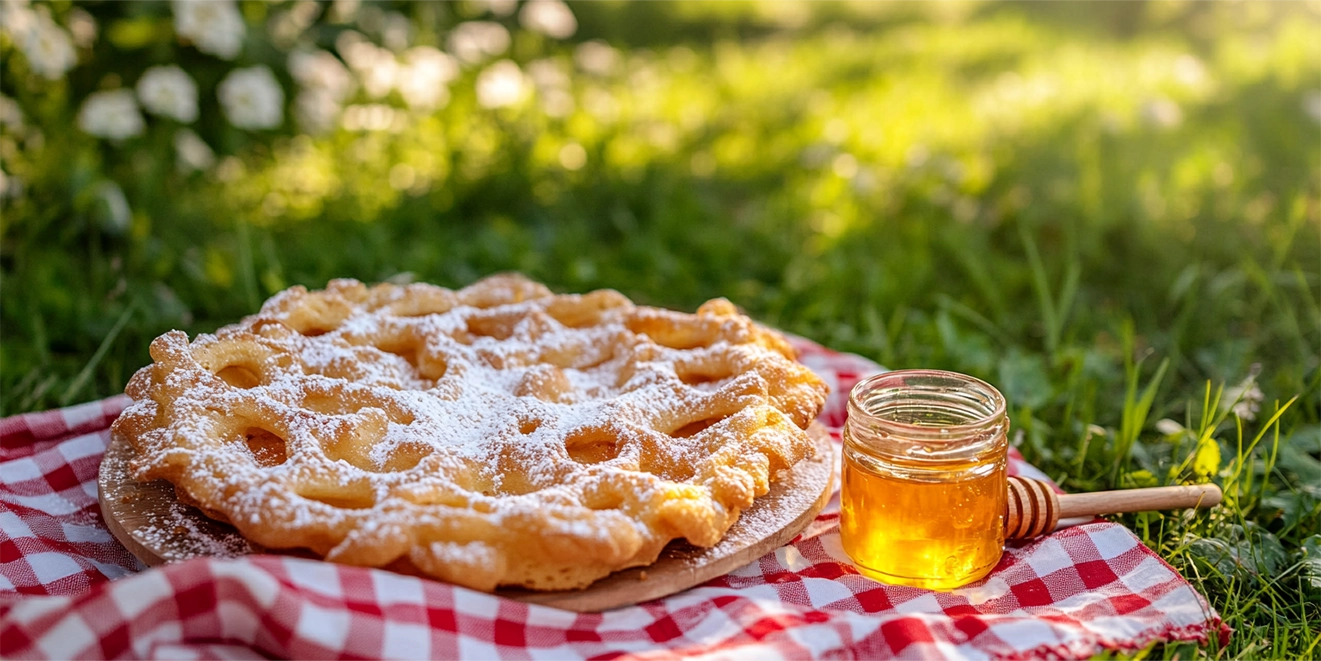How to Make Funnel Cakes at Home: Easy Recipe & Tips for Perfect Results

What is a Funnel Cake?
A funnel cake is a delightful fried treat known for its crispy, golden exterior and light, airy texture. It forms a lacy, web-like pattern by pouring a batter through a funnel or similar tool in a circular, swirling motion into hot oil. Once fried, it’s typically dusted with powdered sugar and can be topped with various delicious options like whipped cream, chocolate sauce, or fresh fruit. Funnel cakes are a staple at carnivals, fairs, and amusement parks, bringing nostalgia and joy to anyone who indulges in their sweet, fried goodness.
Brief History of Funnel Cakes
The origins of funnel cakes can be traced back to medieval Europe, where similar fried dough recipes were enjoyed. The modern version of the funnel cake as we know it was popularized in North America by Pennsylvania Dutch settlers in the 18th and 19th centuries. These settlers adapted traditional German fried dough recipes using readily available ingredients. Today, funnel cakes remain a beloved part of American food culture, primarily associated with outdoor events and celebrations.
Why Make Funnel Cakes at Home?
Making funnel cakes at home allows you to enjoy this classic treat anytime without waiting for the next fair or carnival. It’s a surprisingly easy process that requires only a few simple ingredients, most of which you likely already have in your pantry. By making funnel cakes, you can customize the sweetness, size, and toppings to your liking. It’s an interactive cooking experience for family gatherings or a cozy treat night.
Essential Ingredients for Funnel Cake Batter

To make delicious funnel cakes at home, you need a few pantry staples:
- All-Purpose Flour – The base of the batter that provides structure.
- Granulated Sugar – Adds a touch of sweetness to the batter.
- Baking Powder – Helps create a light and airy texture.
- Salt – Enhances the overall flavor balance.
- Milk – Provides moisture and binds the dry ingredients.
- Eggs – Add richness and help with the batter’s stability.
- Vanilla Extract – Adds a warm, sweet flavor (optional but recommended).
- Vegetable Oil (for frying) – A neutral oil with a high smoke point is essential for frying the cakes.
- Powdered Sugar – For the classic dusting on top after frying.
Recommended Tools for Perfect Funnel Cakes
- Large Mixing Bowl – This is used to combine batter ingredients.
- Whisk or Hand Mixer – To ensure the batter is smooth and lump-free.
- Funnel or Squeeze Bottle – Essential for creating the swirling pattern of the funnel cake.
- Deep Fryer or Large Pot – Used to heat the oil and fry the cakes evenly.
- Slotted Spoon or Tongs – This is used to flip the cakes and safely remove them from the oil.
- Cooling Rack with a Baking Sheet – Drain excess oil and keep the cakes crispy.
- Kitchen Thermometer – Helps maintain the ideal frying temperature (around 375°F or 190°C).
- Serving Plate – To present your beautifully fried funnel cakes with toppings.
- Ingredients You cups of all-purpose flour
- 1 tsp of baking powder
- ½ tsp of salt
- Two large eggs
- 1½ cups of milk
- 1 tsp of vanilla extract
- Powdered sugar for topping
- Vegetable oil for frying
For a similar sweet indulgence, consider checking out this rice krispie treats recipe for another crowd-pleasing dessert option.
How to Make Funnel Cake
- Prepare the Batter: In a bowl, whisk together the dry ingredients—flour, baking powder, and salt. In another bowl, combine eggs, milk, and vanilla extract. Gradually mix the wet ingredients into the dry mixture until smooth.
- Heat the Oil: Fill a deep skillet with about 2 inches of vegetable oil and heat to 375°F.
- Fry the Batter: Transfer the batter to a funnel, piping bag, or squeeze bottle. Carefully swirl the batter into the hot oil in a circular motion. Fry each side for 2–3 minutes until golden brown.
- Dust and Serve: Remove the funnel cake and drain it on paper towels. Sprinkle generously with powdered sugar.
Enhance your knowledge of frying techniques by exploring this guide on how to make a perfect halibut recipe.
Customizing Your Funnel Cake
While the classic powdered sugar topping is a staple, funnel cakes are highly customizable. Popular toppings include:
- Fresh strawberries or bananas
- Whipped cream
- Chocolate drizzle
- Cinnamon sugar
For more inspiration for dessert, look at this apple cobbler recipe.
Pairing Suggestions
Funnel cakes pair wonderfully with light beverages like lemonade or hot drinks like coffee. They’re also a fantastic dessert option for themed dinners, like one featuring chicken quesadillas for a Tex-Mex flair.
Tips for Adjusting Batter Consistency
- Too Thick: If the batter doesn’t squeeze through the funnel or squeeze bottle, add a small amount of milk, one tablespoon at a time, until it reaches the desired consistency.
- Too Thin: If the batter spreads out too much or lacks structure when fried, whisk in a tablespoon of flour at a time until it thickens slightly.
- Rest the Batter: Let the batter rest for 5–10 minutes to allow the ingredients to hydrate fully, ensuring a smoother texture.
Common Mistakes and How to Avoid Them
- Lumpy Batter: Not properly mixing the dry ingredients or rushing the wet-dry combination can result in lumps. Whisk thoroughly to avoid this issue.
- Wrong Consistency: A batter that will spread excessively while one that won’t have a signature lacy pattern. Use the adjustment tips to correct it.
- Overmixing: Overmixing can develop gluten in the flour, making the funnel cake dense instead of light and airy. Stir just until combined.
- Not Testing Oil Temperature: Frying in too cool makes the funnel cakes greasy, while too hot oil can do that. Use a thermometer to maintain a steady 375°F (190°C).
- Rushing the Process: Pouring the batter too quickly into the oil can create clumps instead of a smooth, lacy design. Pour slowly and steadily for the best results.
Choosing the Right Type of Oil

The type of oil you use can significantly affect the taste and texture of your funnel cakes. Here are some options to consider:
- Vegetable Oil: A neutral, budget-friendly choice with a high smoke point, making it ideal for frying.
- Canola Oil: Another neutral option with a slightly lighter flavor and high smoke point.
- Peanut Oil: Provides a slightly richer flavor but may not suit those with allergies.
- Sunflower Oil: A great alternative with a mild taste and high heat tolerance.
Avoid using oils with intense flavors, such as olive or coconut oil, as they can overpower the sweetness of the funnel cake.
Ideal Temperature for Frying Funnel Cakes
- Target Temperature: The oil should be heated to 375°F (190°C) for optimal frying.
- Why This Temperature?: At this temperature, the batter fries quickly, creating a crispy exterior without absorbing too much oil. Lower temperatures can make the cakes greasy, while higher temperatures may burn the batter before it cooks.
- How to Maintain It: A kitchen thermometer monitors the oil temperature. Adjust the heat as needed to keep it steady throughout the frying process.
Safety Precautions While Heating Oil
- Choose the Right Equipment: To minimize the risk of spills and splashes, use a deep, heavy-bottomed pot or a deep fryer.
- Refrain from Overfilling—Fill the don’tpot halfway with oil to allow the bubbling to fry.
- Heat Slowly: Gradually heat the oil over medium heat to avoid overheating and sudden splattering.
- Use a Thermometer: A kitchen thermometer ensures you maintain the correct temperature, reducing the risk of accidents.
- Keep a Lid Nearby: Cover the pot with a lid to extinguish the flames in case of a grease fire. Never use water to douse an oil fire.
- Avoid Water Contact: Ensure utensils, batter, and hands are completely dry before touching the hot oil, as water can cause dangerous splattering.
- Work in Small Batches: Fry one or two funnel cakes simultaneously to prevent overcrowding and oil spills.
- Supervise Constantly: Never leave the hot oil unattended, as it can quickly overheat or become a safety hazard.
Techniques for Pouring Batter
- Use the Right Tool:
- A funnel is the traditional choice. Pour the batter into the funnel, using your finger to block the opening until you’re ready to pouryou’reueeze bottle or piping bag with a medium-sized tip offers more control and is less messy.
- Pour Steadily: Hold the tool a few inches above the hot oil and pour the batter continuously. Avoid stopping mid-pour to ensure a smooth, lacy design.
- Circular and Crisscross Motions: Start pouring the batter in circular motions to form the base, then crisscross over it for the classic funnel cake look.
Achieving the Classic Funnel Cake Shape
- Start in the Center: Begin pouring batter in the center of the pot and work your way outward in a spiral motion.
- Add Layers: Once the base layer is formed, go over it with a few crisscross lines to add structure and texture.
- Control the Thickness: Don’t pour too much Don’tr in one spot—it should remain light and airy. Consistency in the motion is key to achieving the perfect shape.
Timing and Frying Tips for Golden Perfection
- Optimal Frying Time: Fry each funnel cake for 1 to 2 minutes per side or until golden brown. Flip carefully using tongs or a slotted spoon.
- Watch for Bubbles: Once the batter hits the oil, it will bubble and expand. When the bubbles slow down and the edges turn golden, it’s time to flip.
- Tit’soid Overcrowding: Fry one or two funnel cakes at a time to maintain the oil temperature and prevent sticking.
- Drain Excess Oil: Use a slotted spoon to transfer the fried cake onto a cooling rack or a plate lined with paper towels. This helps remove excess oil while keeping the cake crisp.
- Maintain Oil Temperature: If the oil cools, the batter will absorb too much oil and become greasy. If it overheats, the cakes will brown too quickly and remain raw. Adjust the heat to keep the oil at 375°F (190°C).
Traditional Toppings: Powdered Sugar and Syrups

- Powdered Sugar:
- A generous dusting of powdered sugar is the most iconic topping for funnel cakes. It adds a sweet and delicate finish. Use a fine mesh sieve to distribute the sugar evenly.
- Maple Syrup or Honey:
- Drizzle maple syrup or honey over the funnel cake for a simple, sweet touch that complements the crispy texture.
- Caramel or Chocolate Syrup:
- These rich, drizzled syrups are classic choices for a more indulgent flavor.
- Whipped Cream:
- A dollop of fresh whipped cream adds creaminess and balances the crispy texture of the funnel cake.
Creative Variations: Chocolate, Fruits, and More
- Chocolate Lovers:
- Chocolate Chips: Sprinkle mini chocolate chips on the funnel cake while it’s still warm; this will melt them slightly.
- Nutella Drizzle: Spread or drizzle warm Nutella for a decadent chocolate-hazelnut twist.
- Fruity Options:
- Fresh Berries: Top with strawberries, blueberries, raspberries, or a mix for a burst of freshness.
- Fruit Sauces: Drizzle with strawberry, raspberry, or blueberry compote for added flavor and color.
- Bananas and Cinnamon Sugar: For a cozy, comforting treat, add sliced bananas and a sprinkle of cinnamon sugar.
- Decadent Creations:
- Ice Cream: Add a vanilla or chocolate ice cream scoop for a funnel cake sundae.
- Peanut Butter Drizzle: Warm peanut butter makes a rich and nutty topping.
- Candied Nuts: Sprinkle chopped candied pecans or almonds for a crunchy texture.
- Savory Twist:
- Cheese and Herbs: For a savory snack, skip the sugar and add shredded cheese, garlic powder, and fresh herbs.
- Chili or Salsa: For a unique appetizer, create a savory funnel cake base topped with chili, salsa, and shredded cheese.
- Seasonal Variations:
- Pumpkin Spice: Mix pumpkin puree into the batter and top with a dusting of pumpkin spice.
- Peppermint and Chocolate: Add crushed peppermint candies and a drizzle of white chocolate during the holiday season.
Baking Funnel Cakes Instead of Frying
- How to Bake Funnel Cakes:
- Preheat your oven to 375°F (190°C).
- Line a baking sheet with parchment paper and lightly grease it with non-stick spray.
- A piping bag or squeeze bottle can be used to pipe the batter into the classic funnel cake shape directly onto the baking sheet.
- Bake for 15–20 minutes or until golden brown, flipping halfway through for even browning.
- You can finish them under the broiler for 1–2 minutes for extra crispiness, watching closely to prevent burning.
- Benefits of Baking:
- Baking eliminates the need for oil, significantly reducing the calorie and fat content.
- It’s a less messy process, making cleanup easier.
Substituting Ingredients for Healthier Choices
- Flour Substitutes:
- Whole Wheat Flour: Use whole wheat flour instead of all-purpose flour for added fiber and nutrients.
- Gluten-Free Flour: Opt for a gluten-free flour blend if you need a gluten-free option.
- Sweetener Alternatives:
- Natural Sweeteners: For a more natural sweetness, replace granulated sugar with honey, maple syrup, or coconut sugar.
- Sugar Substitutes: Use stevia, erythritol, or monk fruit sweetener to reduce calories without sacrificing sweetness.
- Milk Options:
- Swap regular milk with almond, oat, or any plant-based alternative to make the recipe dairy-free.
- Egg Replacements:
- For a vegan-friendly option, replace eggs with flaxseed meal (1 tablespoon flaxseed meal + 2.5 tablespoons water = 1 egg) or unsweetened applesauce.
- Toppings:
- Replace powdered sugar with a cinnamon or cocoa powder dusting for a lower-sugar option.
- Use fresh fruit or unsweetened yogurt instead of syrups and whipped cream.
Frequently Asked Questions
What is funnel cake batter made from?
Funnel cake batter is typically made from simple ingredients you likely already have in your pantry, including:
- All-purpose flour
- Granulated sugar
- Baking powder
- Salt
- Milk
- Eggs
- Vanilla extract (optional)
The batter is mixed until smooth and is slightly thinner than the pancake batter, allowing it to flow easily through a funnel or similar tool.
How to create a homemade funnel?
If you don’t have a funndon’tou can easily make one or use alternative tools:
- DIY Funnel: Cut the top of a clean plastic bottle, ensuring the opening is wide enough to pour the batter through.
- Alternative Tools: Use a piping bag, a squeeze bottle, or a resealable plastic bag with a small corner snipped off.
These options provide control over the batter flow for shaping your funnel cake.
Is funnel cake batter the same as pancake batter?
Not exactly. While they share similar ingredients, funnel cake batter is usually thinner and less fluffy than pancake batter. Pancake batter is designed to rise and create a soft texture, while funnel cake batter focuses on creating a crispy, lacy structure when fried.
Pancake mix can be used to make funnel cakes by thinning them with extra milk or water.
How to pour funnel cake?
Pouring the batter correctly is key to achieving the classic funnel cake shape:
- Use a Funnel or Squeeze Bottle: These tools give you control over the flow of the batter.
- Start in the Center: Pour the batter in a circular motion from the center outward, creating a spiral pattern.
- Add Crisscross Patterns: Add crisscross lines to create a sturdy web-like structure after the base spiral.
- Pour Slowly: Maintain a steady, slow flow to avoid clumps and ensure an even, airy texture.
Conclusion
Funnel cakes are a timeless treat that brings joy and nostalgia with every bite. By learning how to make them at home, you can recreate the magic of carnival-style funnel cakes anytime you want, right in your kitchen. From mixing the batter and shaping the classic lacy design to frying them to golden perfection and experimenting with toppings, making funnel cakes is a fun and rewarding experience for cooks of all levels.
Whether you stick to traditional recipes or explore healthier alternatives and creative variations, funnel cakes’ versatility ensures something there’sryone. With the tips and techniques shared here, you’re ready to mayou’rehe art of funnel cake making and impress your family and friends with this delightful treat.
So grab your ingredients, heat the oil, and let the sweet aroma of homemade funnel cakes fill your home. Happy cooking!
